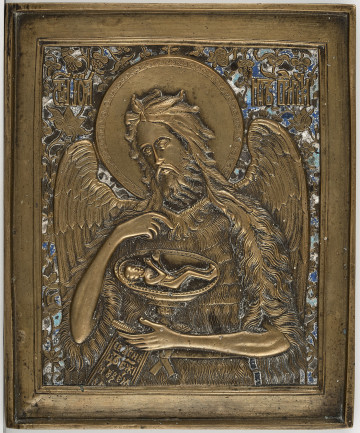
St. John the Baptist
20th century
Castle Museum in Łańcut
Part of the collection: Icons
The icon of the Entrance of the Mother of God into the Temple depicts an event which is not to be found in canonical books, i.e. books considered reliable in Christianity. Nevertheless, the feast of the Entrance of the Mother of God into the Temple is one of the youngest of the twelve most important feasts of the liturgical year celebrated in Orthodox churches. That is why since the development of multi-zone altar partitions in the Ruthenian territories, the icon depicting the feast is placed in the festive row of the iconostasis. Details of the life of the Mother of God appeared in non-canonical apocryphal works. The 2nd-century Protoevangelium of James and the 6th- or 9th-century Latin Gospel of Pseudo-Matthew describe the birth, childhood of Mary and birth of Jesus until the Holy Family fled to Egypt. The biography of the Mother of God is contained in Byzantine writings of the 10th century, such as the manuscript Menologium of Basil II and the Constantinopolitan liturgical books. We learn from them about St Anna, who, having heard the announcement of motherhood from the angel, made a promise to offer the child to the service of God and, together with her husband Joachim, gave the three-year-old Mary to the Temple in Jerusalem. The girl, escorted by her parents, accompanied by a cortege of virgins, was handed over to the care of the priest Zechariah, the father of John the Baptist, and stayed in the Temple until the marriage with Joseph. At the representations of this event, the small figure of Mary is shown in the traditional maphorion covering her figure from head to toe, as is the case in the presented icon, where the procession of virgins has been reduced to a single companion. The Feast of the Entrance of the Mother of God into the Temple is celebrated in Orthodox churches on December 4 (November 21 according to the Julian calendar). Its origins date back to the construction of Jerusalem’s Church of Our Lady the New in 543, becoming widespread from the 11th century, and being ranked among the most important feast in the 14th century. Teresa Bagińska-Żurawska https://orcid.org/0000-0002-9243-3967
Dimensions
height: 35 cm, width: 31 cm
Object type
Icons
Technique
gilding, tempera
Material
gold, tempera, wood
Creation time / dating
Creation / finding place
Owner
Castle Museum in Łańcut
Identification number
Location / status

20th century
Castle Museum in Łańcut

19th (?) century
Castle Museum in Łańcut

1800 — 1850
Castle Museum in Łańcut
DISCOVER this TOPIC
National Museum in Lublin
DISCOVER this PATH
Educational path